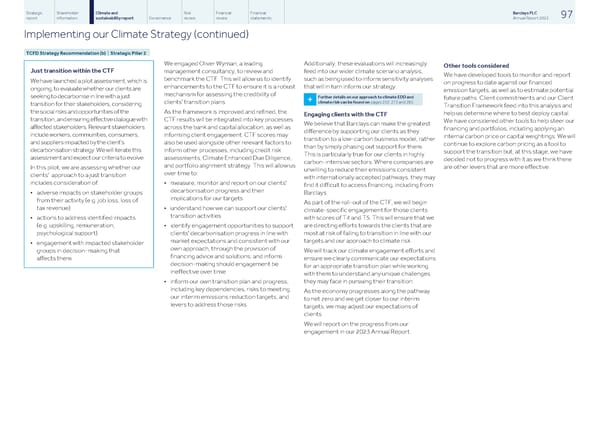Strategic Shareholder Climate and Risk Financial Financial Barclays PLC 97 report information sustainability report Governance review review statements Annual Report 2022 Implementing our Climate Strategy (continued) TCFD Strategy Recommendation (b) | Strategic Pillar 2 We engaged Oliver Wyman, a leading Additionally, these evaluations will increasingly Other tools considered Just transition within the CTF management consultancy, to review and feed into our wider climate scenario analysis, We have developed tools to monitor and report benchmark the CTF. This will allow us to identify such as being used to inform sensitivity analyses We have launched a pilot assessment, which is on progress to date against our financed enhancements to the CTF to ensure it is a robust that will in turn inform our strategy. ongoing, to evaluate whether our clients are emission targets, as well as to estimate potential mechanism for assessing the credibility of seeking to decarbonise in line with a just Further details on our approach to climate EDD and future paths. Client commitments and our Client + climate risk can be found on pages 253, 273 and 285. clients' transition plans. transition for their stakeholders, considering Transition Framework feed into this analysis and the social risks and opportunities of the As the framework is improved and refined, the help us determine where to best deploy capital. Engaging clients with the CTF transition, and ensuring effective dialogue with CTF results will be integrated into key processes We have considered other tools to help steer our We believe that Barclays can make the greatest affected stakeholders. Relevant stakeholders across the bank and capital allocation, as well as financing and portfolios, including applying an difference by supporting our clients as they include workers, communities, consumers, informing client engagement. CTF scores may internal carbon price or capital weightings. We will transition to a low-carbon business model, rather and suppliers impacted by the client’s also be used alongside other relevant factors to continue to explore carbon pricing as a tool to than by simply phasing out support for them. decarbonisation strategy. We will iterate this inform other processes, including credit risk support the transition but, at this stage, we have This is particularly true for our clients in highly assessment and expect our criteria to evolve. assessments, Climate Enhanced Due Diligence, decided not to progress with it as we think there carbon-intensive sectors. Where companies are and portfolio alignment strategy. This will allow us are other levers that are more effective. In this pilot, we are assessing whether our unwilling to reduce their emissions consistent over time to: clients' approach to a just transition with internationally accepted pathways, they may includes consideration of: • measure, monitor and report on our clients' find it difficult to access financing, including from decarbonisation progress and their Barclays. • adverse impacts on stakeholder groups implications for our targets from their activity (e.g. job loss, loss of As part of the roll-out of the CTF, we will begin tax revenue) • understand how we can support our clients' climate-specific engagement for those clients transition activities with scores of T4 and T5. This will ensure that we • actions to address identified impacts are directing efforts towards the clients that are (e.g. upskilling, remuneration, • identify engagement opportunities to support most at risk of failing to transition in line with our psychological support) clients' decarbonisation progress in line with targets and our approach to climate risk. market expectations and consistent with our • engagement with impacted stakeholder own approach, through the provision of We will track our climate engagement efforts and groups in decision-making that financing advice and solutions; and inform ensure we clearly communicate our expectations affects them. decision-making should engagement be for an appropriate transition plan while working ineffective over time with them to understand any unique challenges they may face in pursuing their transition. • inform our own transition plan and progress, including key dependencies, risks to meeting As the economy progresses along the pathway our interim emissions reduction targets, and to net zero and we get closer to our interim levers to address those risks. targets, we may adjust our expectations of clients. We will report on the progress from our engagement in our 2023 Annual Report.
 Barclays PLC - Annual Report - 2022 Page 98 Page 100
Barclays PLC - Annual Report - 2022 Page 98 Page 100